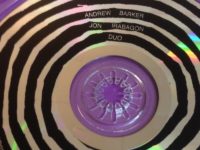We and others have touted saxophonist Jon Irabagon’s long list of awards when discussing him and his music, especially that 2008 Thelonious Monk Saxophone Competition win. But there hadn’t been another Monk winner who can play the mainstream jazz like an old vet and just as ably play anti-jazz establishment music, and you can just sense that Irabagon does it with an impish grin inside.
On September 15, 2015, Irabagon released two albums on his Irabbagast Records imprint that each perfectly presents the extreme sides of Irabagon (and he’s got many shades in-between, too). Behind The Sky is a classic jazz quintet album with the great trumpet player Tom Harrell at his side. This is essentially the long-awaited follow up to the big-label, mainstream jazz release The Observer from way back in 2009. The other CD that the Mostly Other People Do The Killing reedman is unleashing probably won’t get the attention that Sky will (deservedly) get. It’s not really designed to anyway, but the intrigue alone merits an investigation, so here we are.
Inaction Is An Action isn’t the other side of jazz because it’s not even jazz. Recorded entirely with primal sounds wrung from only a sopranino saxophone, Irabagon amasses a collage of sonorities that explores not so much music but the entire timbral possibilities of this horn. That’s not too unlike what his erstwhile drummer Mike Pride was pursuing on his highly experimental Listening Party, except for the extra challenge in doing it all from a single, unaccompanied instrument.
You’ll discover a lot of way how a sopranino sax can sound, and probably little idea as to how it normally sounds. A continuous fog blast defines “Revvvv” while series of ascending legato notes resembling a motorcycle switching gears is heard on “Acrobat.” Irabagon makes that horn grunt like a hog on “What Have We Here” and then plays very unironically melodically on “The Best Kind of Sad,” until about midway through he hits ear-piercing notes. He also plays the sopranino in a more conventional manner during “Ambiwinxtrous” until, again, halfway through, he wrangles a flute sound from it. Getting any sound out at all appears to be a struggle on hushed but labored “Alps”
“Liquid Fire” is the most technically impressive performance, a series rapid-fire note runs sometimes blown like raspberries. And then he appears to be vocalizing through his sax for “Hang Out A Shingle,” like Rahsaan Roland Kirk vocalizing with a flute. How the heck does he do that?!
It doesn’t take a trained ear to conclude that Behind The Sky is way more listenable and, I would add, more recommended. But there’s more than a little satisfaction in hearing the champion of perhaps the most prestigious individual award from the straight jazz world stray way, way off the reservation.



